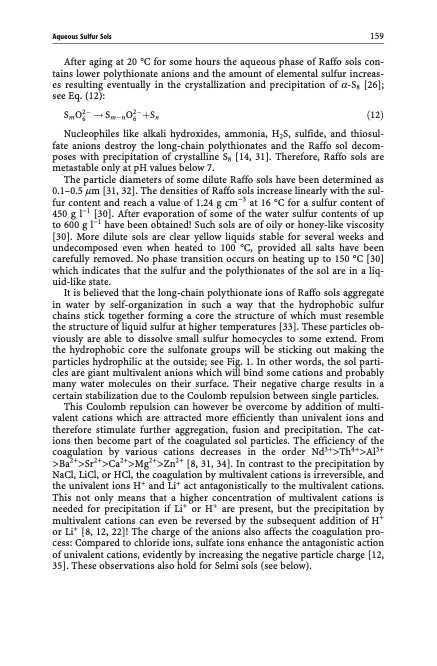
PDF Publication Title:
Text from PDF Page: 169
Aqueous Sulfur Sols 159 After aging at 20 C for some hours the aqueous phase of Raffo sols con- tains lower polythionate anions and the amount of elemental sulfur increas- es resulting eventually in the crystallization and precipitation of a-S8 [26]; see Eq. (12): SmO2 ! SmnO2þSn ð12Þ 66 Nucleophiles like alkali hydroxides, ammonia, H2S, sulfide, and thiosul- fate anions destroy the long-chain polythionates and the Raffo sol decom- poses with precipitation of crystalline S8 [14, 31]. Therefore, Raffo sols are metastable only at pH values below 7. The particle diameters of some dilute Raffo sols have been determined as 0.1–0.5 mm [31, 32]. The densities of Raffo sols increase linearly with the sul- fur content and reach a value of 1.24 g cm3 at 16 C for a sulfur content of 450 g l1 [30]. After evaporation of some of the water sulfur contents of up to 600 g l1 have been obtained! Such sols are of oily or honey-like viscosity [30]. More dilute sols are clear yellow liquids stable for several weeks and undecomposed even when heated to 100 C, provided all salts have been carefully removed. No phase transition occurs on heating up to 150 C [30] which indicates that the sulfur and the polythionates of the sol are in a liq- uid-like state. It is believed that the long-chain polythionate ions of Raffo sols aggregate in water by self-organization in such a way that the hydrophobic sulfur chains stick together forming a core the structure of which must resemble the structure of liquid sulfur at higher temperatures [33]. These particles ob- viously are able to dissolve small sulfur homocycles to some extend. From the hydrophobic core the sulfonate groups will be sticking out making the particles hydrophilic at the outside; see Fig. 1. In other words, the sol parti- cles are giant multivalent anions which will bind some cations and probably many water molecules on their surface. Their negative charge results in a certain stabilization due to the Coulomb repulsion between single particles. This Coulomb repulsion can however be overcome by addition of multi- valent cations which are attracted more efficiently than univalent ions and therefore stimulate further aggregation, fusion and precipitation. The cat- ions then become part of the coagulated sol particles. The efficiency of the coagulation by various cations decreases in the order Nd3+>Th4+>Al3+ >Ba2+>Sr2+>Ca2+>Mg2+>Zn2+ [8, 31, 34]. In contrast to the precipitation by NaCl, LiCl, or HCl, the coagulation by multivalent cations is irreversible, and the univalent ions H+ and Li+ act antagonistically to the multivalent cations. This not only means that a higher concentration of multivalent cations is needed for precipitation if Li+ or H+ are present, but the precipitation by multivalent cations can even be reversed by the subsequent addition of H+ or Li+ [8, 12, 22]! The charge of the anions also affects the coagulation pro- cess: Compared to chloride ions, sulfate ions enhance the antagonistic action of univalent cations, evidently by increasing the negative particle charge [12, 35]. These observations also hold for Selmi sols (see below).PDF Image | Topics in Current Chemistry

PDF Search Title:
Topics in Current ChemistryOriginal File Name Searched:
Elemental-Sulfur-und-Sulfur-Rich-Compounds-I.pdfDIY PDF Search: Google It | Yahoo | Bing
Sulfur Deposition on Carbon Nanofibers using Supercritical CO2 Sulfur Deposition on Carbon Nanofibers using Supercritical CO2. Gamma sulfur also known as mother of pearl sulfur and nacreous sulfur... More Info
CO2 Organic Rankine Cycle Experimenter Platform The supercritical CO2 phase change system is both a heat pump and organic rankine cycle which can be used for those purposes and as a supercritical extractor for advanced subcritical and supercritical extraction technology. Uses include producing nanoparticles, precious metal CO2 extraction, lithium battery recycling, and other applications... More Info
| CONTACT TEL: 608-238-6001 Email: greg@infinityturbine.com | RSS | AMP |